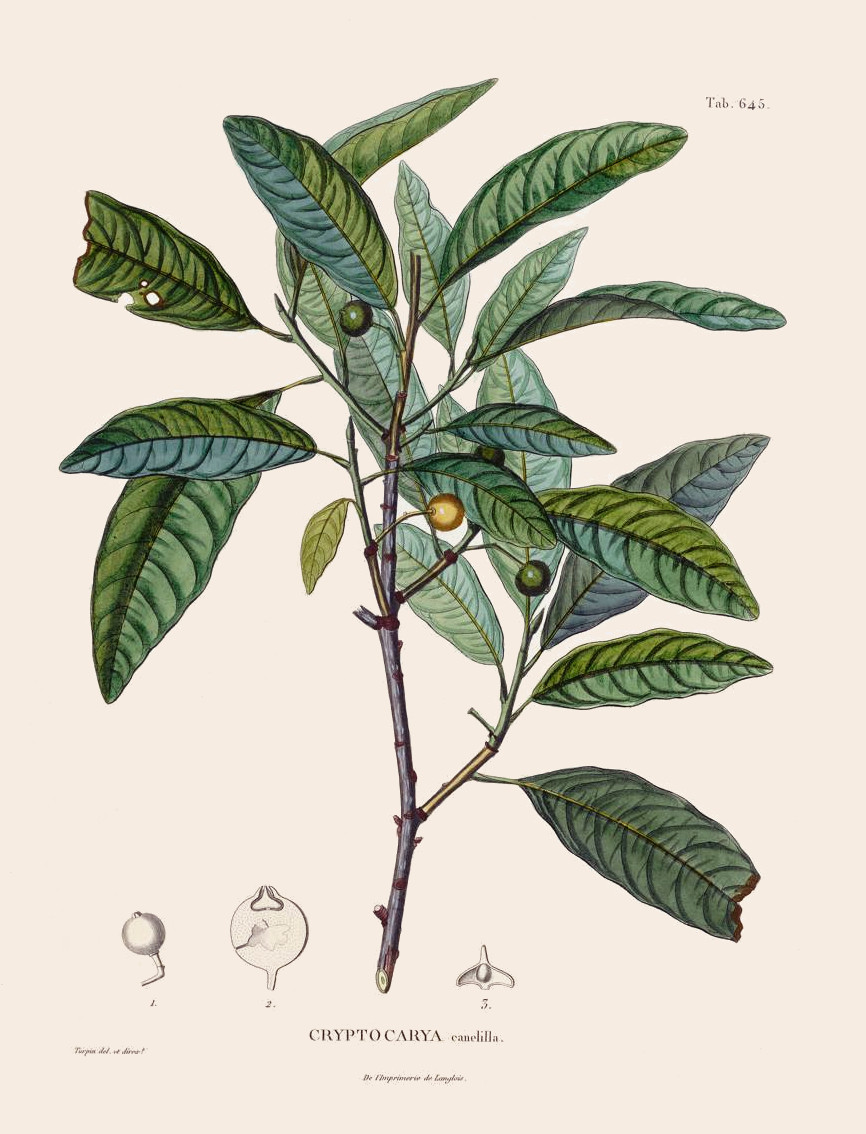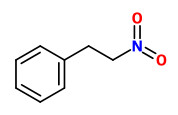Benutzer-Werkzeuge
Aniba canelilla (Kunth) Mez - syn. Cryptocarya canelilla Kunth; Aniba elliptica A.C. Sm. - Lauraceae
canelillo, Casca preciosa, Canelilla, Orinoko-Zimt
Small evergreen tree, up to 7m tall, native to tropical South America; leaves elliptic to obovate-lanceolate; flowers pale yellow, 2.5mm.
[Jahrbuch des Königlichen Botanischen Gartens und des Botanischen Museums zu Berlin., vol.5, 1889, 53-54] http://www.biodiversitylibrary.org/item/150897#page/63/mode/1up
„The species is said to be well known on the Rio Orinoco for its cinnamon-flavored and scented bark. This is sometimes used for making a stimulating tea (Ducke).“
[Lauraceae, Flora of Peru, Field Museum of Natural History - Botany Vol.XIII, 1938]
https://archive.org/stream/cbarchive_47766_lauraceaefloraofperu1938/lauraceaefloraofperu1938_djvu.txt
Extracts of the wood and bark of Aniba canelilla contained the cinnamon-like smelling 1-nitro-2-phenylethane, also found in wood and bark of one variety of O.odorifera. This compound is responsible for the cinnamon-like odour of both trees.
[Gottlieb, Otto, and Maurp Magalhaes. „Communications Occurrence of 1-Nitro-2-phenylethane in Octea pretiosa and Aniba canelilla.“ The Journal of Organic Chemistry 24.12 (1959): 2070-2071]
„The composition of the essential oil and of the hexane extract of the stem bark of Aniba canelilla was analyzed by means of GC/MS, MS and NMR spectroscopy. In addition to confirming the presence of some previously identified constituents such as 1-nitro-2-phenylethane, safrole and eugenol, this study allowed us to identify β-sitosterol, α-pinene, β-pinene, benzaldehyde, phenylacetaldehyde, methoxy eugenol, methyl eugenol, and (−)-selin-11-en-4α-ol. 1-Nitro-2-phenylethane was found to exhibit a high toxicity towards yeasts especially Candida albicans. The LD50 of a petroleum ether extract from this plant was determined to be greater than 800 mg/kg for BALB/c mice.“
[Aniba canelilla (HBK) Mez essential oil: analysis of chemical constituents, fungistatic properties., Oger, J.M., Richomme, P., Guinaudeau, H., Bouchara, J.P., Fournet, A., Journal of Essential Oil Research, 6(5), 1994, 493-497]
Main components of an supercritical fluid extract from A.canelilla bark were 1-nitro-2-phenylethane (71.1%), methyleugenol (9.2%), bisabolol (7.0%), and eugenol (3.9%).
[Composition of the volatile compounds from Aniba canelilla (HBK) Mez. extracted by CO2 in the supercritical state., Vilegas, J.H., Lanças, F.M., Vilegas, W., Revista Brasileira de Farmacognosia, 7(1), 1998, 13-19] http://www.scielo.br/pdf/rbfar/v7-8n1/a02v7-8n1.pdf
„The essential oils of leaves, stem bark and trunk wood of Aniba canelilla, collected in the rainy and dry season from different soil types, were obtained by hydrodistillation and analysed by GC/MS. It has been observed that methyleugenol is also an important volatile constituent in the essential oil of A. canelilla, as well as 1-nitro-2-phenylethane. The percentage content of these two compounds was depending on the season time. In the rainy period the 1-nitro-2-phenylethane reach values near 95%, while methyleugenol remain below 18%. By contrast, in the dry period 1-nitro-2-phenylethane decrease to 39%, while methyleugenol reach 45%. The leaf oils produced from specimens collected at different soil types in the dry season presented the lower percentage contents to 1-nitro-2-phenylethane and methyleugenol. In contrast, the mono- and sesquiterpenes compounds present in the same oils showed the higher percentage contents.“
[Seasonal essential oil variation of Aniba canelilla., Taveira, F.S.N., De Lima, W.N., Andrade, E.H.A., Maia, J.G.S., Biochemical systematics and ecology, 31(1), 2003, 69-75]
„Bark infusions have been used to treat diarrhea, coughs, and as a antispasmodic and stimulant for the nervous system… The essential oil of the leaves [0.8%] and fine stems [0.2%] of Aniba canelilla (Kunth) Mez collected in the city of Manaus, AM, Brazil, were obtained by hydrodistillation and analyzed by GC/MS. Forty-two components were identified, of which 1-nitro-2-phenylethane, as expected, was the major (71.2%-68.2%).“
[Essential oil composition of leaf and fine stem of Aniba canelilla (Kunth) Mez from Manaus, Brazil., Lima, M.D.P., Silva, T.M.D., Silva, J.D.D., Zoghbi, M.D.G.B., Andrade, E.H.A., Acta Amazonica, 34(2), 2004, 329-330] http://www.scielo.br/pdf/aa/v34n2/v34n2a18.pdf
„… i.v. treatment of rats with EOAC [essential oil of the bark of Aniba canelilla] induces dose-dependent hypotension and bradycardia, which occurred independently. The bradycardia appears mainly dependent upon the presence of an operational and functional parasympathetic drive to the heart. However, the hypotension is due to an active vascular relaxation rather than withdrawal of sympathetic tone. This relaxation seems partly mediated by an endothelial L-arginine/nitric oxide pathway through peripheral muscarinic receptor activation (endothelium-dependent relaxation) and predominantly through an inhibition of calcium inward current (endothelium-independent relaxation).“
[Cardiovascular effects of the essential oil of Aniba canelilla bark in normotensive rats., Lahlou, S., Magalhães, P.J.C., de Siqueira, R.J.B., Figueiredo, A.F., Interaminense, L.F.L., Maia, J.G.S., da Cunha Sousa, P.J., Journal of cardiovascular pharmacology, 46(4), 2005, 412-421]
„Aniba canelilla (H.B.K.) Mez is a medicinal plant used in the Amazon folk therapeutic as antispasmodic, antidiarreic, carminative, tonic agent and a stimulant of the digestive and central nervous system. Our preliminary studies showed that the plant essential oil has analgesic activity in mice. Now, we are reporting the antinociceptive effect of the compound 1-nitro-2-phenylethane (97.5%), the main component of the essential oil of Aniba canelilla, which was obtained by column chromatographic purification. In the writhing test this compound was dosed at 15, 25 and 50 mg/kg reducing the abdominal writhes in a significant manner; in the hot plate test it was assayed at 50, 100 and 200 mg/kg producing no alterations in the latency time when compared to the control; and in the formalin test the 1-nitro-2-phenylethane was tested at 50 and 25 mg/kg decreasing significantly the second phase of the algic stimulous. The study suggests that the 1-nitro-2-phenylethane has analgesic activity, probably of peripheral origin. The mechanism involved is not completely understood, however, the results suggest that the opiod receptors are involved in the antinociceptive action observed to 1-nitro-phenylethane.“
[Antinociceptive activity of 1-nitro-2-phenylethane, the main component of Aniba canelilla essential oil., de Lima, A.B., Santana, M.B., Cardoso, A.S., da Silva, J.K.R., Maia, J.G.S., Carvalho, J.C.T., Sousa, P.J.C., Phytomedicine, 16(6), 2009, 555-559]

Humboldt, F.H.A. von, Bonpland, A., Kunth, K.S., Nova genera et species plantarum (coloured version), vol.7 t.645 (1825) [P.J.F. Turpin]
http://plantgenera.org/species.php?id_species=65091

